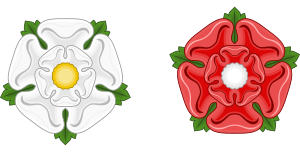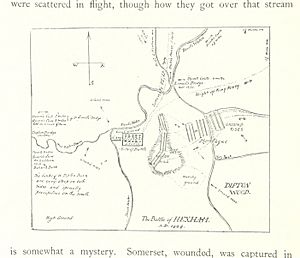Battle of Hexham facts for kids
Quick facts for kids Battle of Hexham |
|||||||
|---|---|---|---|---|---|---|---|
| Part of the Wars of the Roses | |||||||
 |
|||||||
|
|||||||
| Belligerents | |||||||
| Commanders and leaders | |||||||
| Strength | |||||||
| 3,000-4,000 | unknown | ||||||
| Casualties and losses | |||||||
| unknown (Significantly fewer than Lancastrian forces) | unknown (Significantly more than Yorkist forces) | ||||||
The Battle of Hexham took place on May 15, 1464. It was a major event in the Wars of the Roses. These wars were a long fight between two powerful families in England. They were the House of Lancaster (who used a red rose as their symbol) and the House of York (who used a white rose).
This battle was fought near the town of Hexham in Northumberland. It marked a big win for the Yorkist side. After this battle, the Lancastrians had much less power in northern England. This helped Edward IV, the Yorkist king, secure his rule.
Contents
Why the Battle Happened
The Wars of the Roses Explained
The Wars of the Roses were a series of civil wars in England. They lasted for over 30 years, from 1455 to 1487. The main reason for the wars was who should be king of England. Both the House of Lancaster and the House of York believed they had the right to the throne.
Lancastrian Challenges in the North
After a big battle called the Battle of Towton, the Lancastrians were weaker. They couldn't stop the Yorkists from making peace with Scotland. This meant their safe areas in the north of England were now in danger.
So, the Lancastrians decided to try and get more support. They planned a campaign in northern England. They hoped to gather a large army before King Edward IV could bring his own forces north.
Meeting at Hexham
The Lancastrian army moved through Northumberland in April 1464. They were led by the Duke of Somerset. They gathered soldiers from different Lancastrian strongholds.
However, they had already lost a battle called Battle of Hedgeley Moor. This was on April 25, 1464, against a Yorkist army. That army was led by John Neville, also known as Lord Montagu. The Lancastrians met Neville's forces again near Hexham. The two armies faced each other on May 14, 1464.
The Battle of Hexham
Where the Armies Fought
The Lancastrian army had set up their camp near Linnels Bridge. This bridge crosses a small river called the Devil's Water. It is just south of Hexham.
The Yorkist army, led by Lord Montagu, crossed the River Tyne on the night of May 12-13. By the morning of May 14, they were ready to attack Hexham. The Yorkists moved very quickly. The Lancastrians were caught by surprise and had little time to get ready.
The Yorkist Attack
The Duke of Somerset quickly moved his soldiers to a spot near Linnels Bridge. He arranged his troops in three groups in a field near the Devil's Water. He hoped to fight the Yorkist army there before they could reach Hexham.
But as soon as the Lancastrians were in position, the Yorkists attacked. They charged down from higher ground. The right side of the Lancastrian army, led by Lord Roos, saw the Yorkists coming. They immediately ran away, crossing the Devil's Water and heading towards Hexham. This happened before any fighting even started.
The Lancastrian Collapse
With one part of their army fleeing, the rest of Somerset's forces were in a terrible spot. They were surrounded and couldn't move easily. The Yorkist soldiers charged through a gap at one end of the field. They quickly overwhelmed the confused Lancastrian soldiers.
The Lancastrian army lost all hope. After a short fight, the remaining soldiers were pushed into the Devil's Water. Many drowned in the river. Others were crushed trying to climb the steep banks as they ran towards Hexham. Most of them were trapped in a nearby forest called West Dipton Wood. They had no choice but to surrender when the Yorkists arrived.
After the Battle
Leaders Captured and Executed
Lord Montagu, the Yorkist commander, was very harsh after the battle. On the evening of the battle, many important Lancastrian leaders were captured and put to death in Hexham. This included Henry Beaufort, 3rd Duke of Somerset, and Lord Roos. Sir William Tailboys was also caught and executed. He had tried to escape north with a large amount of money meant for the war.
With their leaders gone and their money lost, the Lancastrian resistance in northern England quickly fell apart.
King Henry VI's Escape and Capture
King Henry VI, the Lancastrian king, was kept safe away from the battle. He had been captured three times before, so his supporters made sure he escaped to the north.
After his defeat at Hexham, Henry VI found hiding places with Lancastrian supporters. He stayed in different houses across northern England, including Muncaster Castle and Bolton Hall. Later, he was hiding at Waddington Hall in Waddington, Lancashire.
However, he was betrayed by someone and was captured on July 13, 1465. A group of Yorkist men arrested him. Henry VI tried to run into nearby woods but was soon caught. His capture meant that the Lancastrian rebellion was mostly over for a while.
A Period of Peace
After the Battle of Hexham and the capture of Henry VI, there was a time of relative peace in England. This lasted until 1469. In that year, the Earl of Warwick, who had been a strong Yorkist supporter, changed sides. He decided to support the Lancastrian cause, and the wars began again.


